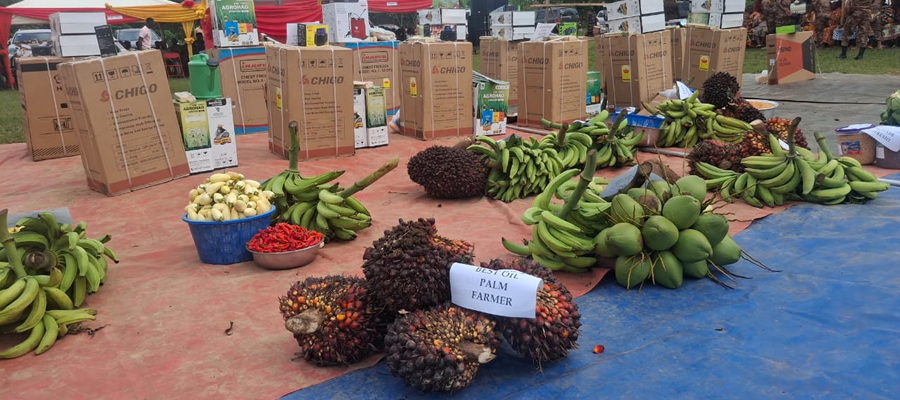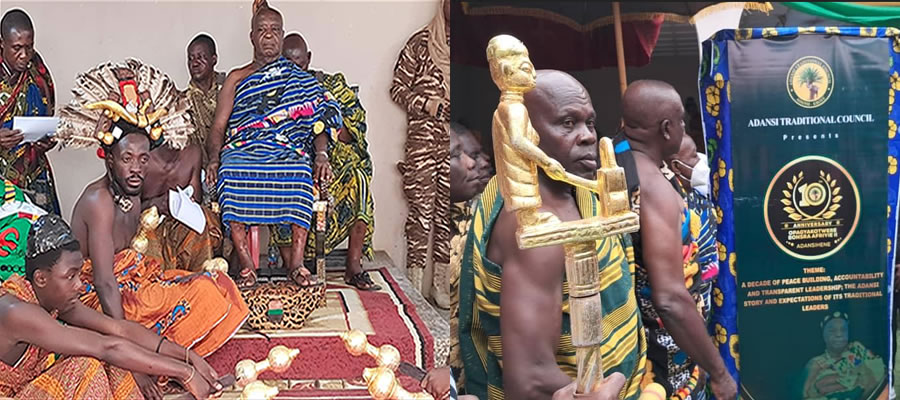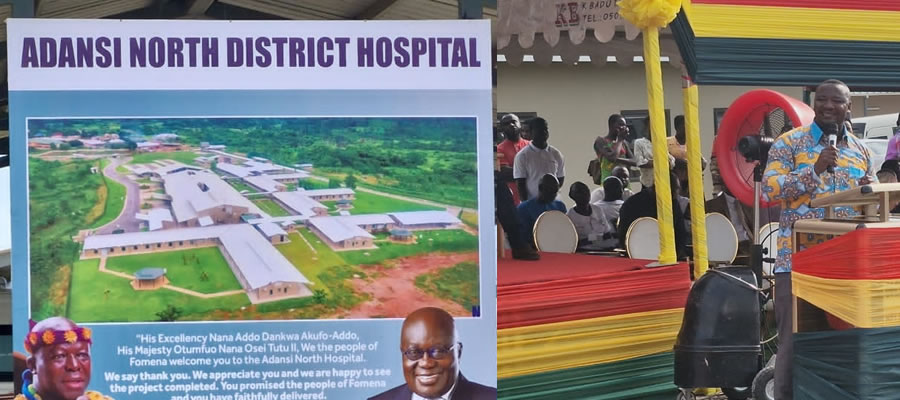

1. ADMINISTRATIVE STRUCTURES FOR ADANSI NORTH DISTRICT MANAGEMENT
The administrative set up to facilitate governance in the district is co-terminus with the Local Government Act 462 of the 1992 Fourth Republic Constitution. The General Assembly is the highest authority of the District Assembly. It has deliberative, legislative as well as executive functions among which is development decision-making and planning.
The Presiding Member is the highest authority in the General Assembly which is made up of all Assembly members, the District Chief Executive and Heads of Department. The District Co-coordinating Director is the secretary to the General Assembly.
a. ADANSI NORTH DISTRICT ASSEMBLY
The District was created by the Legislative Instrument 1758 and inaugurated on the 17th February, 2004. Adansi North District is one of the newly created Districts in Ghana. It is one of the 30 administrative districts in Ashanti Region.
The district was carved out of the defunct Adansi East and Adansi West Districts, now Adansi South and Obuasi District Assembly respectively. The District has 43 electoral areas according to the 2010 General Election and seven Area Councils namely; Fomena, Dompoase, Anhwiaso, Akrokerri, Fumso, Bodwesango and Asokwa.
b. Organizational Structure of the Assembly
The District Assembly is made up of the District Chief Executive who is the political head, and 61 Assembly members of which 43 are elected and 18 appointed by the President in consultation with chiefs and interest groups in the District. The Members of Parliament for the Adansi Asokwa and Fomena constituencies are ex-officio members of the Assembly and a sitting Presiding Member elected from among the Assembly members to chair the Assembly’s proceedings.
The Assembly performs its functions through the Executive Committee and a number of sub-committees. The Executive Committee exercises executive and co-ordinating functions of the Assembly whilst the Sub-Committees are called to deliberate on relevant issues in their functional areas. The Executive committee, which performs the functions of the Assembly is presided over by the District Chief Executive and consists of not more than 2/3 of the total number of members of the Assembly. Heads of Department attend meetings of the committee as ex-officio members and advise them on the execution of their functions. All chairpersons of sub-committees are members of the Executive Committee.
The statutory sub-committees include the following;
- Development planning sub-committee;
- Social services sub-committee;
- Works sub-committee;
- Finance and Administration sub-committee;
- Justice and security sub-committee; and
- Public relations and complaints sub-committee.
Sub-committees are important sub-structures of the Assembly as far as planning is concerned. All letters, proposals, plans and development input from unit committees are channeled through the Area Councils to the office of the District Chief Executive and referred to the appropriate sub-committees of the Executive committee. Conventionally, there are supposed to be five sub-committees that deal with various developmental issues in the Assembly.
These are Development Planning Sub-committee, Social Services Sub-committee, Works Sub-committee, Justice and Security Sub-committee and Finance and Administration Sub-committee. However, in line with the legal provision that empowers the District to establish additional sub-committee when the need demands, three more sub-committees have been established in the District,namely ; Agriculture Development Sub-committee and Education Sub-committee.
For administrative efficiency and effectiveness, the District Chief Executive is supported by a secretariat or the Central Administration which is headed by the District Co-ordinating Director who reports to the District Chief Executive.
The District Assembly also has the District Planning Co-ordinating Unit (DPCU) which is to serve as the technical section of the Assembly by developing a data bank for planning and budgeting purposes. This unit has not been functioning as expected largely owing to staff inadequacy and logistical constraints.
The Central Administration of the office of the District Assembly is basically made up of the following two (2) broad departments.
i General Administration and Finance
ii District Planning Co-ordinating Unit
These are supported by the following departments;
- Department of Social Welfare and Community Development
- Ghana National Fire Service
- Ghana Education Service
- Ghana Health Service
- National Commission for Civic Education
- Electoral Commission
- Department of Agriculture
- Works Department
- Department of Co-operatives
- National Board for Small Scale Industries
- Town and Country Planning Department.
- Statistical Service
The following Departments, Agencies and Institutions are not in existence in the district. Their services are however provided from Obuasi and Bekwai where most of them exist. They are:
- Lands Commission
- District Labour Office
- Land Valuation
- Survey Department
- Department of Parks and Gardens
- Forestry
The absence of these decentralized departments and vital institutions like Land Valuation, Electricity Company etc. poses serious problems with service delivery in the district.
c. AREA COUNCILS
The Adansi North District has seven Area Councils. They are:
Almost all the Area Councils have permanent Area Council buildings except Anwiaso Area Council building which was awarded on contract but has been abandoned by the contractor. Despite the fact that the remaining (six) 6 area councils have permanent structure, three of them have problem with office accommodation. Presently, Fomena Area Council building is being used by Adansi North District Assembly as temporary office while the new structure for the Assembly has been awarded on contract. Dompoase Area Council structure is also occupied by the District Education Directorate owing to the fact that they do not have permanent office at Fomena, the district capital. Also Fumso Area Council building is now been used as a Health Centre to serve the people of the area.
All the area councils have clerk of councils that are manning them. However, the other staff who are supposed to support the clerk of councils are not in place. This is because they are paid from revenue items that have been ceded to them. Thus most of them who are qualified to do the job are not attracted enough.
At best, they are taken on for two to three months and they tender in their resignation forbetter job. For personnel to be attracted to the job, the central government should take up their salaries. Besides, the personnel problem, the councils do not have the necessary logistics to work with. For instance, at this computer age, with the exception of Fomena and Akrokerri Area Councils, the rest of the area councils are without computers. None of them has any means of transport and telephone facilities.
d. TRADITIONAL AUTHORITY
The whole district falls in the Adansi Traditional Area with their headquarters as the District capital, Fomena. Adansihene is the final traditional authority on the land. Under him are the various divisional chiefs and sub-chiefs. The chiefs adjudicate on family disputes and also mobilize the citizenry for communal labour.
2. ACCOUNTABILITY
The District Chief Executive is the Administrative and Political head of the Assembly and he is accountable to the General Assembly, the Regional Minister, the Minister of Local Government, Rural Development and to the President of the Republic of Ghana.
The D.C.E. is supposed to sign performance agreement periodically with the Regional Minister. He is also accountable to the General Assembly by the delivery of sessional address. The sessional address is discussed thoroughly by the General Assembly before consideration and acceptance. The D.C.E meets the citizenry periodically to defend the policies and initiatives of the Assembly through questions and answers during the Town Hall meeting.
The D.C.E is under the scrutiny of the media daily on his decisions and utterances. The Internal Auditor of the District Assembly and external Auditors are always scrutinizing the final performances of the District Assembly and the financial culpability of the D.C.E. The D.C.E is responsible to the communities by accepting their invitation to ceremonies, durbars and inaugurations.
The District Coordinating Director on the other hand is the head of the bureaucracy in the district. He is in charge of the day to day administration of the Assembly and he coordinates all departments and sees to their effective performance. He is responsible to the Regional Coordinating Director, the Regional Minister, the Minister of Local Government, Rural Development and Environment and the Head of Civil Service through the submission of quarterly reports, situation reports and any other assignment given for response.
Finally, the D.C.E and the D.C.D are under the eagle eye of the Finance and Administration sub-committee for effective financial and administration performance in the district.
3. PARTICIPATION OF THE CITIZENRY
a. COMMUNITIES
The communities operate around the Unit committees through to the Assembly members, the Area Councils to the District Assembly.The chiefs are also a major rallying force within the communities and there is the need for collaboration between these institutions for effective mobilization of the citizenry for communal work. It is noted that areas in the District where there is absence of such collaboration between the unit committees and the chiefs always brings about apathy and total breakdown of communal cooperation.
b. COMMUNITY BASED ORGANIZATIONS (CBOS)
Community Based Organizations abound in the district with the majority formed around HIV/AIDS but they are not well structured and formally organized. The other CBOS are formed around Farmers’ Associations, Hair Dressers’ and Dress Makers’ Associations.
c. PRIVATE SECTOR INSTITUTIONS
Adansi North District is predominantly an agricultural economy. However, private farmland holdings are relatively small in size and the average farm holding size is below 1 hectare. At best there are only pockets of farmers who could be described as medium scale farmers. Small-scale commercial farm owners dominate the private sector.
There exist private purchasing companies whose operations are of immense importance to farmers and the economy in general. The following private purchasing companies exist in the district. Kuapa, Fedco, Adwumapa, Produce Buying Company, etc. Other Private sector Institutions are millers (rice, maize, cassava, palm oil) timber merchants, sawn millers, processors and a medium scale wooden processing industry at Dompoase. Asokwa, Anwona, Fumso and Tasiliman.
The predominance of agriculture in the district and the high output in agricultural raw materials, make the district a potential force to reckon with in the establishment of processing industries. It is also a potential for the majority of the youth to be trained in non-traditional agricultural production. The Assembly has taken the lead and has started gradually in the training of the youth in snail rearing, bee-keeping and mushroom production.
The District has one rural bank namely; Adansi Rural Bank Ltd which has its branches at Akrokerri and Asokwa with its headquarters at Fomena, the district capital. Bosome Freho Rural Bank which has its headquarters at Asiwa, the district capital for Bosome Freho District Assembly an adjoining district. The bank has an agency at Bodwesango.
Contractors, the garages, welders, plumbers, dressmakers, hair dressers, carpenters and masons are the main nucleus of substantial employment for our stream of J.S.S. and S.S.S students that come yearly.
d. F I R E:
1. DOMESTIC FIRE
Cases of domestic fire were received from Anhwiaso and Nyankumasu. Superficially, the number of cases is very insignificant. In all these cases, indiscriminate handling of naked flames has caused the hazard.
2. BUSH FIRE
Bush fires caused by individuals have been on the low side. This would be attributed to the intensive educational campaign mounted by NADMO in conjunction with the National Fire Service and Agricultural Extension Agents. Communities are always advised to grow green belts to protect their settlements.
e. DISASTER MANAGEMENT
Management of disasters in the district is very effective. They are managed based on the kind of disaster that occurs at a particular location. The disasters which normally occur in the district include domestic/bushfire outbreaks, rainstorms, epidemics and so on.
When communities in the district are hit by rainstorms, the District Directorate of NADMO liaises with the District Assembly, the Regional Directorate of NADMO and the National Headquarters of NADMO for a befitting relief package to be sent to the affected community.
If there is a fire outbreak, both domestic and bushfires alike, the District Directorate of NADMO in collaboration with the outfit of the District Fire Service and the District Directorate of MOFA to bring all fire outbreaks under control, after which the necessary relief packages are given to the victims.
If an epidemic breaks out, the District Directorate of NADMO liaises with the District Directorate of Health Services to bring the situation under control.
Date Created : 11/10/2017 3:02:25 AM













 facebook
facebook
 twitter
twitter
 Youtube
Youtube
 +233 593 831 280
+233 593 831 280 0800 430 430
0800 430 430 GPS: GE-231-4383
GPS: GE-231-4383 info@ghanadistricts.com
info@ghanadistricts.com Box GP1044, Accra, Ghana
Box GP1044, Accra, Ghana